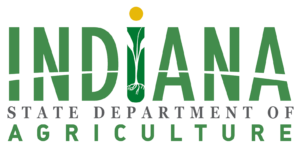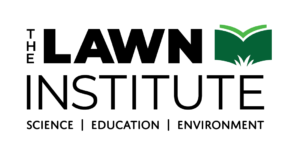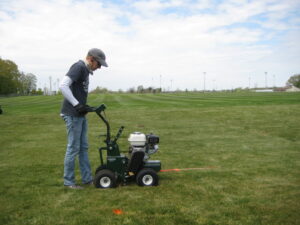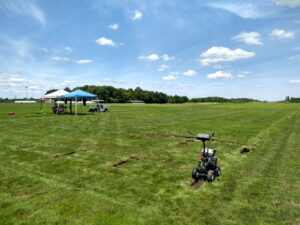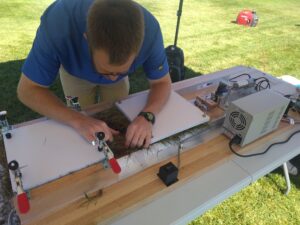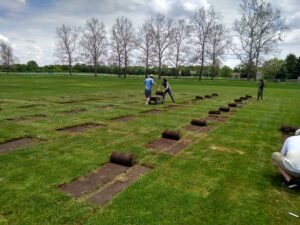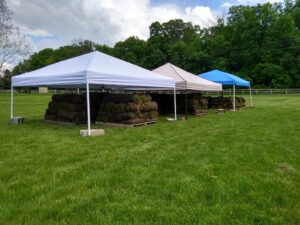Sod Production
Sod is an important specialty crop in the northern U.S., representing over $549 million in combined sales from the Northeast, Midwest, Plains, and Northwest regions of the US, and this value is expected to increase. Sod is important for new construction to prevent soil erosion and increase ecosystem services from turfgrass in urban and suburban areas. Recent genetic improvements in low-input turfgrass species now provide sod farms new options besides Kentucky bluegrass when selecting what to plant. Since the selection of turfgrasses (either low or high-input) by sod farms ultimately impacts the level of input required by those receiving sod installations (homeowners), decisions made by sod farmers and landscape contractors can have a tremendous impact on the environment and efforts to manage turf sustainably.
Data from collaborative research at Purdue University and University of Minnesota investigating low-input sod production funded by ISDA/USDA-AMS shows promising results with fine fescue sod production, especially with strong creeping red fescue (Festuca rubra ssp. rubra) because of its rhizome system. Results from this sod research also shows us that there is much variability in horizontal spread between genotypes of strong creeping red fescue. This indicates there may be potential differences among cultivars within a fine fescue species or subspecies which we are studying in 2022-2023.
Additionally, preliminary results from a The Lawn Institute-funded experiment in 2020 at Purdue University titled “Identification of Successful Nitrogen Fertilization Establishment Regimes for Fine Fescue Sod Production” is showing that strong creeping red fescue is producing the highest strong strength, slender creeping red fescue (F. rubra ssp. littoralis) is the next highest, and then Chewings fescue and hard fescue (Festuca brevipila) is the lowest sod strength among fine fescues. Preliminary results from this experiment is also demonstrating that plant genetics and not nitrogen fertilization has the greatest impact on sod strength.
Our team continues to research how to produce turfgrass sod sustainably in the Midwest.
Extension Publications
Philocles, S., A. Torres, E. Watkins, and A. Patton. 2021. Projected Costs and Returns Associated with the Production
of Kentucky Bluegrass: A Study of Economic Feasibility in Indiana and Iowa. Purdue Extension Publication HO-288-W. https://www.extension.purdue.edu/extmedia/HO/HO-288-W.pdf
Philocles, S., A. Torres, E. Watkins, A. Patton, Gomez, M. C.U. 2022. Economics of tall fescue sod production in the Midwest. Purdue Extension Publication HO-258-W. https://www.extension.purdue.edu/extmedia/HO/HO-258-W.pdf
Philocles, S., A. Torres, E. Watkins, A. Patton. 2023. Marketing of Low-Input Turfgrass in the Northern US. Purdue Extension Publication HO-338-W. https://www.extension.purdue.edu/extmedia/HO/HO-338-W.pdf
Research Publications
Braun, R. C., Watkins, E., Hollman, A. B., Mihelich, N. T., & Patton, A. J. (2022). Management, harvest, and storage characteristics of low-input cool-season turfgrass sod mixtures. Agronomy Journal, online. https://doi.org/10.1002/agj2.21051
Braun, R.C., & Patton, A.J. 2022. Species, clover-inclusion, and nitrogen fertilizer effects on sod tensile strength of fine fescue taxa. Agronomy Journal, online. https://doi.org/10.1002/agj2.21039
Braun, R.C., E. Watkins, A.B. Hollman, N.T. Mihelich, and A.J. Patton. 2021. Investigation of cool-season species, seeding rate, and nitrogen fertilization in sod production: I. Establishment and sod tensile strength. Agronomy Journal, 113, 4176–4189. https://doi.org/10.1002/agj2.20810
Braun, R.C., E. Watkins, A.B. Hollman, N.T. Mihelich, and A.J. Patton. 2021. Investigation of cool-season species, seeding rate, and nitrogen fertilization in sod production: II. Management and shelf life. Agronomy Journal. 113:3460–3474. https://doi.org/10.1002/agj2.20777
Presentations
Sod Financial Calculator
https://www.purdue.edu/hla/sod-financial-calculator/
Funding
This research was supported by 1) the Agricultural Marketing Service, U.S. Department of Agriculture, Multi-State Specialty Crops Block Grant through the Indiana State Department of Agriculture, under award number A337-19-SCMP-18-001, and also by 2) The Lawn Institute.
